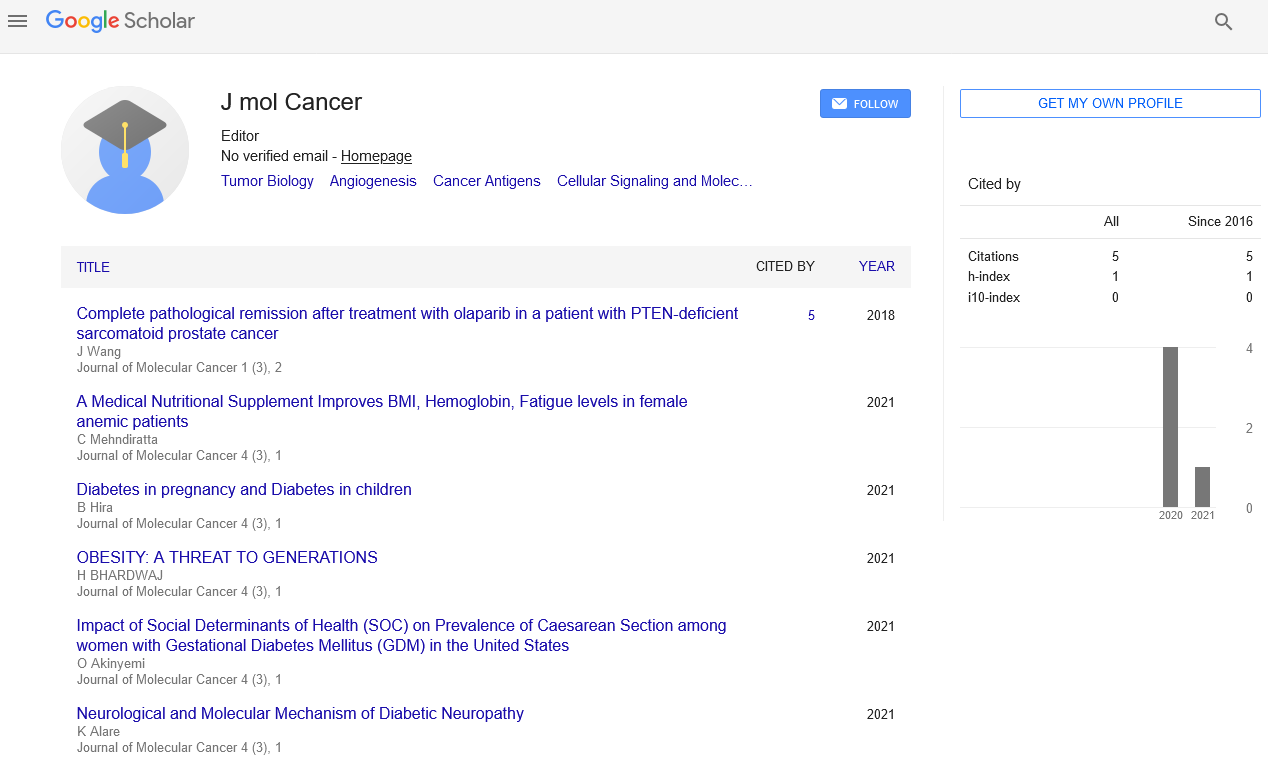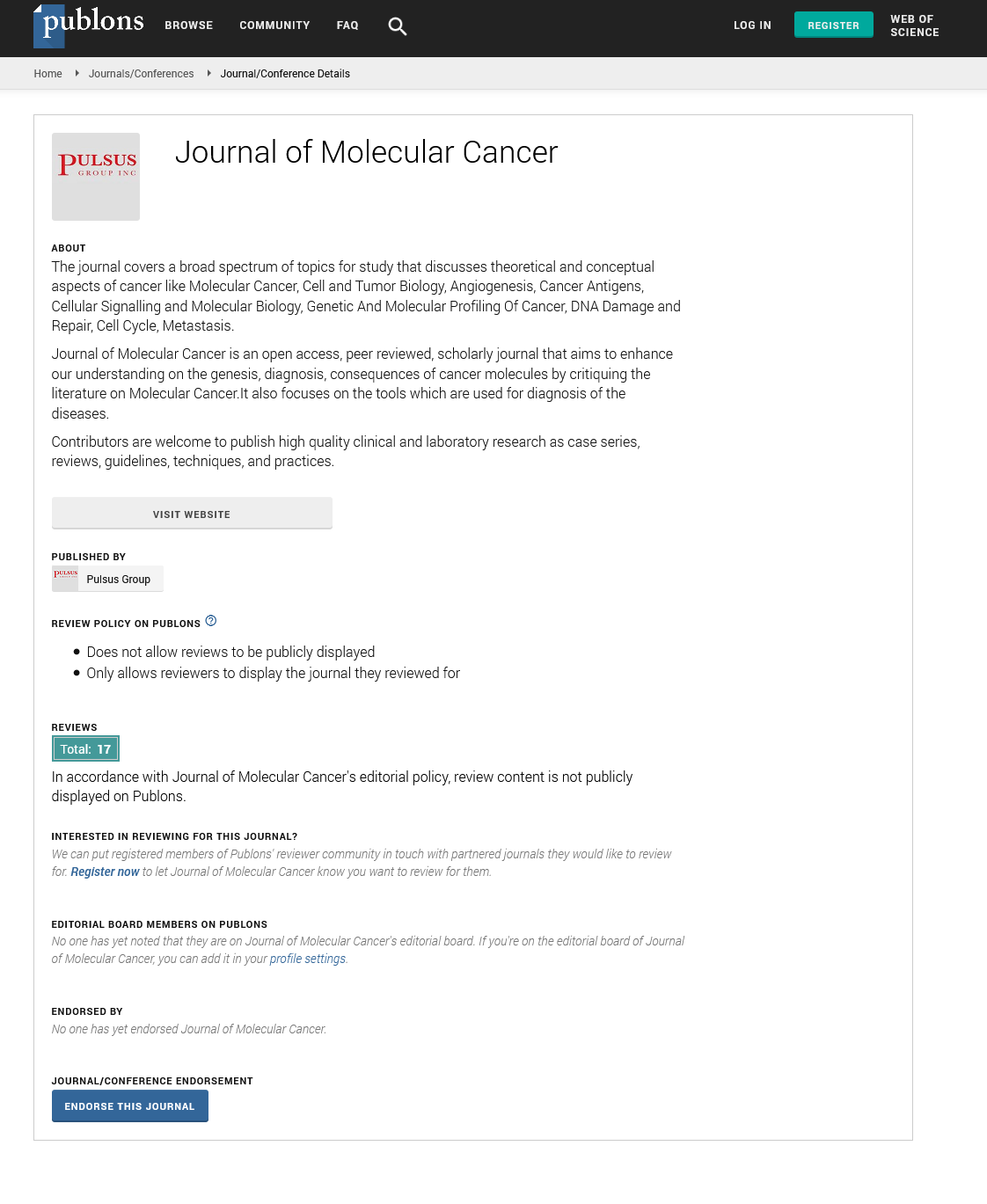Tyrosine kinase inhibitors: A targeted therapy
Received: 14-Mar-2022, Manuscript No. puljmc-22-4485; Editor assigned: 16-Mar-2022, Pre QC No. puljmc-22-4485(PQ); Accepted Date: Mar 14, 2022; Reviewed: 21-Mar-2022 QC No. puljmc-22-4485(Q); Revised: 25-Mar-2022, Manuscript No. puljmc-22-4485(R); Published: 28-Mar-2022, DOI: DOI:10.37532/puljmc.22.5(2).14-15
Citation: Grey A. Tyrosine kinase inhibitors: a targeted therapy. J Mol Cancer. 2022; 5(2):14-15.
This open-access article is distributed under the terms of the Creative Commons Attribution Non-Commercial License (CC BY-NC) (http://creativecommons.org/licenses/by-nc/4.0/), which permits reuse, distribution and reproduction of the article, provided that the original work is properly cited and the reuse is restricted to noncommercial purposes. For commercial reuse, contact reprints@pulsus.com
Abstract
A few clinical preliminaries have as of late introduced their most recent information, giving examination of patient's endurance benefits and antagonistic occasions. Starting outcomes have exhibited promising viability and wellbeing information. Some clinical case reports and review investigation showed that EGFR/ALK TKIs can altogether further develop PFS and the pace of extremist medical procedure. Nonetheless, there was no genuinely huge distinction in general endurance season of practically all clinical preliminaries. TKIs are progressively acknowledged by clinicians as acceptance treatment in NSCLC. Many investigations have shown that neoadjuvant treatment improves the probability of medical procedure and is related with great resection rates, as confirmed by high imminent downstaging rates in patients with privately progressed NSCLC. Notwithstanding, the gamble of repeat stays high without any proof of generally endurance benefits being accounted for. Now that more clinical preliminaries are being led and more information will be accessible for investigation, a clearer and more thorough perspective on which job TKIs play in enlistment treatment will arise.
Key Words
Tyrosine kinase inhibitors, Chemotherapy, Auxiliary endpoints
Abstract
A few clinical preliminaries have as of late introduced their most recent information, giving examination of patient's endurance benefits and antagonistic occasions. Starting outcomes have exhibited promising viability and wellbeing information. Some clinical case reports and review investigation showed that EGFR/ALK TKIs can altogether further develop PFS and the pace of extremist medical procedure. Nonetheless, there was no genuinely huge distinction in general endurance season of practically all clinical preliminaries. TKIs are progressively acknowledged by clinicians as acceptance treatment in NSCLC. Many investigations have shown that neoadjuvant treatment improves the probability of medical procedure and is related with great resection rates, as confirmed by high imminent downstaging rates in patients with privately progressed NSCLC. Notwithstanding, the gamble of repeat stays high without any proof of generally endurance benefits being accounted for. Now that more clinical preliminaries are being led and more information will be accessible for investigation, a clearer and more thorough perspective on which job TKIs play in enlistment treatment will arise.
Introduction
Non-small-cell Cellular Breakdown in the Lungs (NSCLC) is the most well-known sort of cellular breakdown in the lungs and is customarily dealt with activity, radiotherapy, and is customarily dealt with activity, radiotherapy, chemotherapy and target treatment. Five-year generally Endurance (OS) rate after stage II-IIIA cellular breakdown in the lungs resection is assessed to be somewhere in the range of 41 and 65%. The advancement of designated treatment has improved cellular breakdown in the lungs medicines. Epidermal Development Factor Receptor (EGFR) transformations, for example, 19 cancellations and L858R changes are oftentimes found in patients of East Asia. Improvement of the Anaplastic Lymphoma Kinase (ALK) quality is an unmistakable subtype of cellular breakdown in the lungs. Tyrosine Kinase Inhibitors (TKIs) of EGFR and ALK have shown phenomenal viability in cutting edge EGFR-transformation positive and ALKrevamped NSCLC. Tyrosine kinase inhibitors as acceptance treatment incorporates preoperative and preconcurrent chemo radiotherapy. TKI treatment and preoperative treatment with EGFR-TKI are of worry to numerous oncologists. To start with, endurance benefits are normal. Second, further developing the careful resection rate and decreasing the postoperative repeat rate are likewise significant. Acceptance treatment can possibly contract growth mass, further develop total resection rate and diminish the gamble of repeat. Then again, neoadjuvant treatment could defer the medical procedure and have hazard of illness movement. Late clinical preliminary information investigated the possibility of EGFR-TKI neoadjuvant treatment. The essential endpoint of most clinical preliminaries directed on EGFR-TKI neoadjuvant treatment was Objective Reaction Rate (ORR), which is characterized as the extent of patients accomplishing Total Reaction (CR) or Incomplete Reaction (PR) as per RECIST variant 1.1. Auxiliary endpoints were Sans Illness Endurance (DFS), OS, the pace of Major Pathologic Reaction (MPR), and antagonistic occasions.
Tyrosine kinase inhibitors
Three single-arm imminent stage II examinations utilized different treatment regimens to decide the adequacy and security of EGFR-TKI neoadjuvant treatment. In 2019, a stage II review showed that neoadjuvant erlotinib was very much endured and could further develop the extreme resection rate in patients with stage IIIA-N2 EGFR change positive NSCLC. The ORR was 42.1%; 89.5% (17/19) of patients accomplished infectious prevention, with a 10.3-month middle DFS among patients who went through a medical procedure. Among every one of the 19 patients who got neoadjuvant treatment, media PFS and OS were 11.2 and 51.6 months, individually. Unfriendly occasions happened in 36.8% (7/19) of patients, and 15.8% experienced grade 3/4 unfavorable occasions. TP53 quality change (7/8) notwithstanding an EGFR transformation was especially fascinating. Having no TP53 transformation, or exceptionally low overflow, was related with longer PFS, while high overflow was related with short PFS (8 months). In this way, accompanying transformation may altogether affect the adequacy of TKI neoadjuvant treatment. In 2019, in one more stage II review, intercalated blend of erlotinib and gemcitabine/ cisplatin or carboplatin as neoadjuvant treatment with stage IIIA NSCLC gave various outcomes. The ORR was 46.15%, and middle DFS was 20 months. Patients with EGFR transformations had a higher ORR (85.7%). Be that as it may, middle OS was only 25 months, and changed EGFR was related with an expanded mortality risk versus wild-type EGFR and obscure EGFR mutational status. A few information of randomized preliminaries showed critical endurance advantage of EGFR-TKI as neoadjuvant treatment. In 2019, 31 treatment-gullible Chinese patients with stage IIIA NSCLC were selected. Patients without EGFR change got cisplatin-based doublet chemotherapy (n = 16) though EGFR-freak patients got erlotinib (n = 15) as neoadjuvant treatment. Patients who got erlotinib had a barely better clinical objective reaction rate (67 versus 19%), neurotic reaction rate (67 versus 38%), and generally speaking endurance (51 months versus 20.9 months) contrasted and the individuals who got chemotherapy. The huge improvement of OS was a result of the contrast between the two gatherings, EGFR freak and wild sort patients. As a third-age, irreversible EGFR-TKI that specifically hinders both EGFR-TKI-sharpening and EGFR T790M obstruction changes, osimertinib showed viability better than that of standard EGFR-TKIs in the primary line treatment of EGFRm progressed NSCLC, with a comparable security profile and lower paces of genuine antagonistic occasions.
Conclusion
Stage IIIA NSCLC patients are a heterogeneous gathering with different introductions going from evidently resectable cancers with mysterious minute nodal metastases to unresectable multistation nodal illness. As referenced before, clinical preliminary information proposed TKI neoadjuvant treatment could initiate cancer downstaging, further developing total resection rate. Arising CTONG 1103 showed that no pathologic complete reaction was recognized in either erlotinib or GC chemotherapy arms. In a forthcoming, single-arm, stage II review, the extreme resection rate was 68.4%, and MPR was 24.2% in another stage II review. The essential endpoint of these preliminaries was ORR, which was 42-67%. In 2020, a stage II review with gefitinib as neoadjuvant treatment for resectable stage II-IIIA NSCLC disease showed that ORR was 54.5% and MPR was 24.2%. Middle DFS was 33.5 months and middle OS was not reached. No persistent was accounted for grade 3 or 4 unfriendly occasions. At present, the ORR and wellbeing of EGFR/ALK TKIs as enlistment treatment of stage II-IIIA NSCLC have been affirmed. TKI enlistment treatment could actuate growth down staging, further developing total resection rate. In any case, there has not been proof of by and large endurance advantages and diminishing the gamble of repeat. We are anticipating enormous scope randomized controlled preliminaries exploring the job of TKIs in perioperative treatment, joining acceptance and adjuvant medicines to improve customized treatment later on.






